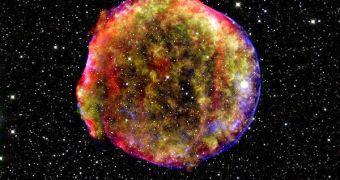Gleaming at supernova remnants (SNR) is not always easy, mostly because they are either very distant, or because they are surrounded by large amounts of dust. In either case, direct observations become very difficult, because only observatories working in radio, infrared, or ultraviolet wavelengths can pierce through the thick clouds.
The area behind large dust clouds has long been established as a taboo zone for optical observatories, but researchers at the North Carolina State University (NC State) have managed to develop a mathematical model that makes it easier to correct the distortions that appear in telescopes' lenses when looking through gas and dust clouds.
The target of their research has been the G1.9+0.3 remnant, which is the youngest such formation to be detected in the Milky Way. It's believed to have exploded some 25,000 years ago, but its light only reached the Earth about 140 years ago, when it was first discovered. It has been accurately observed in recent times, via the use of NASA's Chandra X-ray Observatory and the VLA radio observatory, which have provided clear images of the SNR.
According to recent studies, the formation was generated by a Type Ia supernova explosion, which means that it came from a collapsing white dwarf. Now, experts seek to understand exactly how the magnetic fields that this type of stars generates have influenced the generation of cosmic ray particles, which have been identified as coming out of the SNR.
These particles are extremely important in the grand scheme of things, because they help in the creation of other stars, thus recycling the material that has been shed by a collapsing red giant star. However, how these rays, which are made from fast-traveling subatomic particles, have been exactly formed still remains a mystery to this day. At the same time, researchers find themselves in the impossibility to say whether these cosmic rays have other roles in addition to recycling other matter, or not.
“We knew the dust was a problem – it's why we never saw the original supernova light in Victorian times. Our high-powered orbiting telescopes use X-rays to take pictures of these objects, and the dust scatters these X-rays, so in order to get data that might be helpful to us, we first had to correct for the dust distortion,” NC State Physicist Dr. Stephen Reynolds, who has been a member of the team that has gone over all readings registering details of G1.9+0.3 that have been available, says.
“We use supernovae as flashbulbs across the universe (a means to make assumptions about how the universe works. Shockwaves from the explosions and the fast-moving cosmic particles that come from them play roles in galaxy formation. If we can figure out how these particles are energized, and how magnetic fields affect them, we'll be able to answer all sorts of questions about our universe,” he adds.

 14 DAY TRIAL //
14 DAY TRIAL //